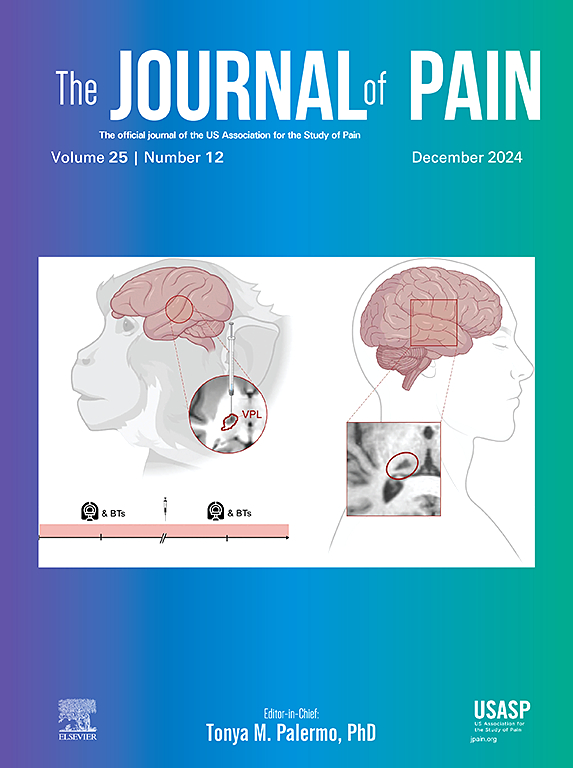Contemporary media campaigns for musculoskeletal pain: A systematic review and meta-analysis with social marketing benchmarking
IF 4
2区 医学
Q1 CLINICAL NEUROLOGY
引用次数: 0
Abstract
Musculoskeletal pain is a global public health problem. Social marketing aims to increase adoption of desired behaviours in target audiences and may uncover new strategies to improve uptake of helpful pain-related behaviours at the population-level. We systematically evaluated effects of contemporary mass media campaigns targeting musculoskeletal pain and used social marketing benchmarking to explore strategies associated with campaign success. Published evaluations of campaigns involving an online/digital component and a comparator/control condition were eligible. The primary outcome was population beliefs; secondary outcomes were healthcare provider beliefs, behavioural (e.g., healthcare-related, work-related), clinical (e.g., pain), and economic outcomes. Decision-rules and meta-analyses (random-effects models) were used to synthesise findings. Eight databases and grey literature were searched from inception to May 2024. Thirteen eligible publications evaluated eight campaigns (N = 5 back pain, N = 2 rheumatic pain; N = 1 work-related pain) from eight Western/high-income countries. All evaluations reported historical control data (interrupted time-series/before-and-after designs); three also compared selected outcomes to an unexposed geographical region (quasi-experimental designs). Risk of bias was weak-moderate for all evaluations. Population beliefs improved from baseline vs. final follow-up (1.5–10yrs) for items related to ‘staying active’ [RR = 1.38 (95%CI: 1.14–1.67), N = 4 campaigns, n = 12,568 participants] and ‘rest’ [RR = 1.35 (95%CI: 1.14–1.60), N = 5 campaigns, n = 14,571 participants] for pain management, however, certainty of evidence was very low. Other outcomes were not pooled due to heterogeneity, and evidence was mixed. Greater numbers of social marketing benchmarks were associated with successful campaign outcomes. Future campaigns should implement social marketing strategies beyond education alone, including behaviour change support, to facilitate adoption of desired pain-related behaviours.
Registration
PROSPERO registration number: CRD42023400456; Open Science Framework (detailed Social Marketing Benchmarking analysis plan): https://osf.io/npyck/.
Perspective
We systematically evaluated contemporary mass media campaigns targeting musculoskeletal pain. Promising improvements in population beliefs about pain supports continued investment into campaigns. Our review provides critical new information including social marketing strategies to ensure future campaign efforts shift population-level pain-related behaviours, towards reducing the societal burden of pain.
针对肌肉骨骼疼痛的当代媒体宣传:以社会营销为基准的系统回顾和荟萃分析。
肌肉骨骼疼痛是一个全球性的公共健康问题。社会营销的目的是提高目标受众对理想行为的采纳,并可能发现新的策略来提高人群对与疼痛相关的有益行为的采纳。我们系统地评估了针对肌肉骨骼疼痛的当代大众媒体活动的效果,并使用社会营销基准来探索与活动成功相关的策略。已发表的对涉及在线/数字内容和参照/对照条件的宣传活动的评估符合条件。主要结果是人群的信念;次要结果是医疗服务提供者的信念、行为(如与医疗相关、与工作相关)、临床(如疼痛)和经济结果。采用决策规则和荟萃分析(随机效应模型)来综合研究结果。检索了从开始到 2024 年 5 月的八个数据库和灰色文献。13 篇符合条件的出版物评估了来自 8 个西方/高收入国家的 8 项活动(N=5 项背痛、N=2 项风湿痛;N=1 项工作相关疼痛)。所有评估都报告了历史对照数据(间断时间序列/前后设计);三项评估还将选定结果与未受影响的地理区域进行了比较(准实验设计)。所有评估的偏倚风险均为弱-中等。从基线到最终随访(1.5-10 年),与 "保持活跃"[RR=1.38(95%CI:1.14-1.67),N=4 项活动,n=12,568 名参与者] 和 "休息"[RR=1.35(95%CI:1.14-1.60),N=5 项活动,n=14,571 名参与者] 有关的疼痛管理项目的人群信念有所改善,但证据的确定性很低。由于存在异质性,其他结果未进行汇总,证据也参差不齐。更多的社会营销基准与活动的成功结果相关。未来的宣传活动应实施社会营销策略,而不仅仅是教育,包括行为改变支持,以促进人们采取所期望的疼痛相关行为。注册:PROSPERO 注册号:CRD42023400456;开放科学框架(详细的社会营销基准分析计划):https://osf.io/npyck/ 观点:我们系统地评估了当代针对肌肉骨骼疼痛的大众媒体宣传活动。人们对疼痛的看法有望得到改善,这支持了我们对宣传活动的持续投资。我们的综述提供了重要的新信息,包括社会营销策略,以确保未来的宣传活动能改变人们与疼痛相关的行为,从而减轻疼痛带来的社会负担。
本文章由计算机程序翻译,如有差异,请以英文原文为准。
求助全文
约1分钟内获得全文
求助全文
来源期刊

Journal of Pain
医学-临床神经学
CiteScore
6.30
自引率
7.50%
发文量
441
审稿时长
42 days
期刊介绍:
The Journal of Pain publishes original articles related to all aspects of pain, including clinical and basic research, patient care, education, and health policy. Articles selected for publication in the Journal are most commonly reports of original clinical research or reports of original basic research. In addition, invited critical reviews, including meta analyses of drugs for pain management, invited commentaries on reviews, and exceptional case studies are published in the Journal. The mission of the Journal is to improve the care of patients in pain by providing a forum for clinical researchers, basic scientists, clinicians, and other health professionals to publish original research.
 求助内容:
求助内容: 应助结果提醒方式:
应助结果提醒方式:


